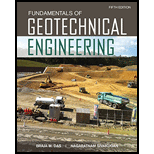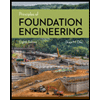
Concept explainers
State whether the following are true or false.
- a. Load carrying capacities of timber piles are less than those of steel or concrete piles.
- b. If the load carried by the pile cross section decreases linearly with depth, the frictional resistance per unit remains the same at all depths.
- c. The point load is mobilized well before the shaft load.
- d. Soil-pile friction angle δ′ can be greater than the friction angle of the soil ϕ′.
- e. Bored piles are high displacement piles.
(a)
State whether the statement “Load carrying capacities of timber piles are less than those of steel or concrete piles” is true or false.
Answer to Problem 18.1P
The given statement is
Explanation of Solution
The steel piles have a usual load carrying capacity of 300kN to 1200kN.
The concrete piles have a load carrying capacity of 300 kN to 3000 kN.
The timber pile has a load carrying capacity value of 300 kN to 500 kN.
Hence, the load carrying capacities of timber is less than concrete or steel.
Therefore, the given statement is
(b)
State whether the load carried by the pile cross section decreases linearly with depth and the frictional resistance per unit remains the same at all depths is true or false.
Answer to Problem 18.1P
The given statement is
Explanation of Solution
Determine the unit area frictional resistance
Here, p is the pile cross section perimeter,
As per the formula, the change in pile load remains constant, when the pile load is increasing linearly with depth. Conversely, the perimeter and the change in depth have the inverse relationship with depth. Therefore,
Therefore, the given statement is
(c)
State whether the point load is mobilized well before the shaft load is true or false.
Answer to Problem 18.1P
The given statement is
Explanation of Solution
If the shaft load is large, it depends on the pile diameter. The ultimate shaft resistance is not principally mobilized before the point load
Therefore, the given statement is
(d)
State whether the statement “soil-pile friction angle
Answer to Problem 18.1P
The given statement is
Explanation of Solution
The magnitude of soil-pile friction angle
Therefore, the given statement is
(e)
State whether the given statement “bored piles are high displacement piles” is true or false.
Answer to Problem 18.1P
The given statement is
Explanation of Solution
Bored piles cause the soil to be displaced radially as well as vertically as pile shaft is driven. For bored piles, the holes are initially bored in the ground and then pile is formed in this hole. Bored piles displace very less amount of soil.
Therefore, the given statement is
Want to see more full solutions like this?
Chapter 18 Solutions
Fundamentals of Geotechnical Engineering (MindTap Course List)
- Refer to Figure 18.9. A cantilever sheet pile is driven into a granular soil where the water table is 2 m (L1) below the top of the sand. The properties of the sand are =40, =17.5kN/m3, and sat=19kN/m3. It is proposed to excavate to a depth of 6 m (L) below the ground level. Determine the actual depth to which the sheet pile must be driven (L + D), using the net lateral pressure diagram. Note: Dactual=1.3(L3+L4)theoryarrow_forwardIn Problem 18.4, find the maximum bending moment in the sheet pile and determine the required section modulus, assuming an allowable stress of 190 MN/m2. 18.4 Refer to Figure 18.13. Given L1 = 1.5 m, L2 = 3 m; for the sand, =33, =16.5kN/m3, sat=19.0kN/m3; and, for the clay, c=50kN/m2, =0, sat=20kN/m3. Determine the depth of sheet pile required, allowing for a 50% increase from the theoretical estimate.arrow_forwardA braced sheet pile to be used in an open cut in clay is shown in the figure. Struts are spaced longitudinally at 2.5 m center to center spacing. Unit weight of clay is 20 kN/cu.m and an unconfined compressive strength of 100 kN/m2. Determine the section modulus of wale at B if the allowable bending stress is 0.6 Fy where Fy = 248 MPaarrow_forward
- A circular pile having a diameter of 0.35 m is embedded through a layer of 4.5 m thick of clay layer into a dense sand having a bearing capacity factor of 78. Unit weight of clay is 16 kN/m3 and saturated unit weight of sand is 18 kN/m3. Water table is located at the top of the sand layer. Lateral pressure factor of compression K = 1.20 and coefficient of friction of concrete pile is 0.42. The allowable capacity 600 kN. Using a factor of safety of 3. Determine the effective vertical stress at the critical depth.arrow_forwardA 600mm diameter pile is embedded in 3 layers of dense sand at a depth of 17m. Nq = 86. The groundwater table is situated between Layers 2 and 3. The layers have the following properties: Layer 1: γ = 16.9 kN/m3. 3m thick. Layer 2: γ = 17.6 kN/m3. 5.5m thick. Layer 3: γsat = 19.65 kN/m3. K is 0.9 and tan α = 0.37. The factor of safety is 3.0. What is the skin friction resistance of the pile in kN? None of the choices 1684.170 1477.156 1257.150 1322.744 866.118 Please answer this asap. For upvote. Thank you vey much.arrow_forwardDetermine the ultimate load capacity of a circular pile with diameter D = 20 cm installed in asaturated soft clay. The pile is embedded 10 m into the ground. According to measurements, thesoil exhibits an undrained shear strength according to the linear relationship: Su = 2+1.6z, wherez is the depth in meters and Su is the undrained shear strength in kPa. The soil's unit weight canbe assumed as 18 kN/m3arrow_forward
- cantilever sheet pile shown. below, determine: A)the depth of embedment (d). B)the maximum moment.arrow_forwardA 300 mm diameter steel pipe pile with 10 mm wall thickness is to be driven to a depth of 15 m in a stiff clay having ET = 100 MPa. The side friction capacity, ΣfnAs, is 750 kN and the toe bearing capacity, q'nAt, is 210 kN. The expected service load will be 310 kN. Using the Fleming simplified method, compute the expected settlement. Assume fn is constant along the length of the pile.arrow_forwardIn Hiley’s formula for driven piles i.e. R=E/(s+0.5c), why is a coefficient of 0.5 applied for the term elastic deformation of piles and soil?arrow_forward
- State the method to determine the N-value of soil and the normal N-value required for supporting friction pilesarrow_forwardA steel pile (H-section; HP 360 1.491; see Table 18.1) is driven into a layer of sandstone The length of the pile is 18.9 m. Following are the properties of the sandstone: Unconfined compression strength = qu(lab) = 78.7 MN/m2 Angle of friction = 36 Using a factor of safety of 3, estimate the allowable point load that can be carried by the pile. Use Eq. (18.42).arrow_forward
 Principles of Foundation Engineering (MindTap Cou...Civil EngineeringISBN:9781337705028Author:Braja M. Das, Nagaratnam SivakuganPublisher:Cengage Learning
Principles of Foundation Engineering (MindTap Cou...Civil EngineeringISBN:9781337705028Author:Braja M. Das, Nagaratnam SivakuganPublisher:Cengage Learning Fundamentals of Geotechnical Engineering (MindTap...Civil EngineeringISBN:9781305635180Author:Braja M. Das, Nagaratnam SivakuganPublisher:Cengage Learning
Fundamentals of Geotechnical Engineering (MindTap...Civil EngineeringISBN:9781305635180Author:Braja M. Das, Nagaratnam SivakuganPublisher:Cengage Learning Principles of Foundation Engineering (MindTap Cou...Civil EngineeringISBN:9781305081550Author:Braja M. DasPublisher:Cengage Learning
Principles of Foundation Engineering (MindTap Cou...Civil EngineeringISBN:9781305081550Author:Braja M. DasPublisher:Cengage Learning


